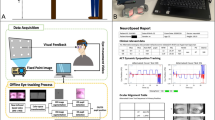Abstract
The purpose of this study was to evaluate the reliability of the fixation preference testing with 10 and 20 diopter prisms (Δ) in children without strabismus in order to extrapolate its utility to preverbal children and to determine interexaminer agreement. Fourty children (24 girls, 16 boys) aged between 5 and 16 years with normal ophthalmological examination except refractive errors were included in the study. The visual acuity, refractive errors, and orthoptic findings were recorded. The base-down prism fixation test was performed by two experienced examiners with 10Δ and 20Δ. The presence of corrective movement was recorded as positive result separately for each eye. Best-corrected visual acuity was 1.0 bilaterally for all patients. All patients had binocular single vision and stereopsis. First examiner noted bilateral fixation movement in 65 % patients with 10Δ and in 57.5 % with 20Δ, second examiner in 50 % with 10Δ, and in 37.5 % with 20Δ. Interexaminer agreement was 42.5 % for 10Δ and 54.5 % for 20Δ (p < 0.01). Both examiners observed the fixation movement to be less frequent in older children. The fixation movement can be absent or seen asymmetrically even in children with equal visual acuity and binocular vision. The rate of fixation movement seemed to be reduced with age possibly due to increased concentration and cooperation of the child. In addition, there was a remarkable interexaminer variability in both tests. It should be borne in mind that the findings of prism-guided fixation preference tests may be misleading in preverbal children.
Similar content being viewed by others
References
Whittaker KW, O’Flynn E, Manners RM (2000) Diagnosis of amblyopia using the 10-diopter fixation test: a proposed modification for patients with unilateral ptosis. J Pediatr Ophthalmol Strabismus 37:21–23
Wright KW, Walonker F, Edelman P (1981) 10-Diopter fixation test for amblyopia. Arch Ophthalmol 99:1242–1246
Wallace DK (2005) Tests of fixation preference for amblyopia. Am Orthopt J 55:76–81
Koklanis K, Le T, Georgievski Z (2010) The base-to-base induced-tropia prism test for detection of amblyopia: a pilot study. J AAPOS 14:484–487
Wright KW, Edelman PM, Walonker F, Yiu S (1986) Reliability of fixation preference testing in diagnosing amblyopia. Arch Ophthalmol 104:549–553
Friedman DS, Katz J, Repka MX, Giordano L, Ibironke J, Hawse P, Tielsch JM (2008) Lack of concordance between fixation preference and HOTV optotype visual acuity in preschool children: the Baltimore pediatric eye disease study. Ophthalmology 115:1796–1799
Cotter SA, Tarczy-Hornoch K, Song E, Lin J, Borchert M, Azen SP et al (2009) Fixation preference and visual acuity testing in a population based cohort of preschool children with amblyopia risk factors. Ophthalmology 116:145–153
Acknowledgments
The authors did not receive any financial support for this study.
Author information
Authors and Affiliations
Corresponding author
Ethics declarations
Conflict of interest
The authors have no proprietary interest in any of the materials used in this study.
Rights and permissions
About this article
Cite this article
Erkan Turan, K., Taylan Sekeroglu, H., Karahan, S. et al. Reliability and interexaminer agreement for induced tropia test: is normal always normal?. Int Ophthalmol 37, 615–618 (2017). https://doi.org/10.1007/s10792-016-0312-6
Received:
Accepted:
Published:
Issue Date:
DOI: https://doi.org/10.1007/s10792-016-0312-6




